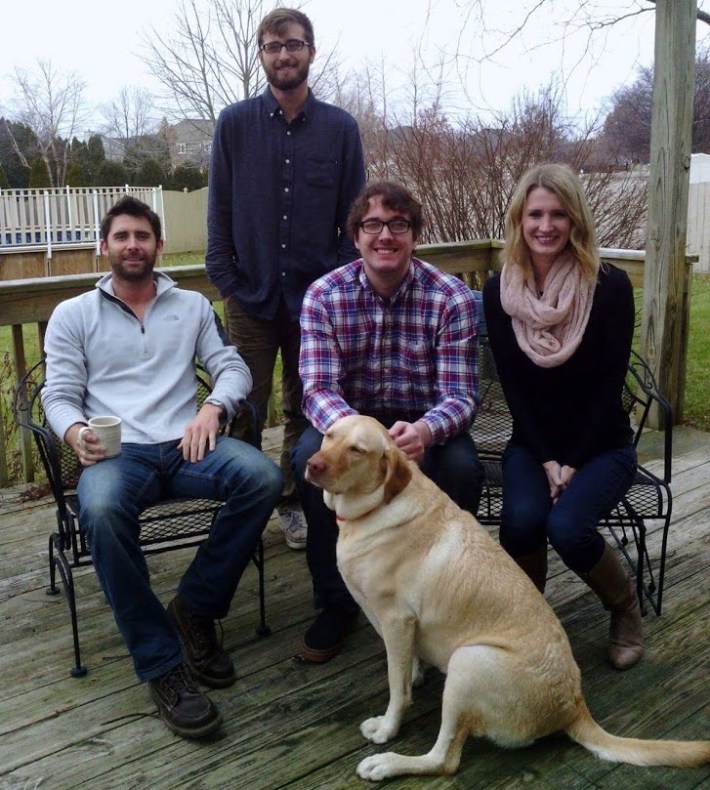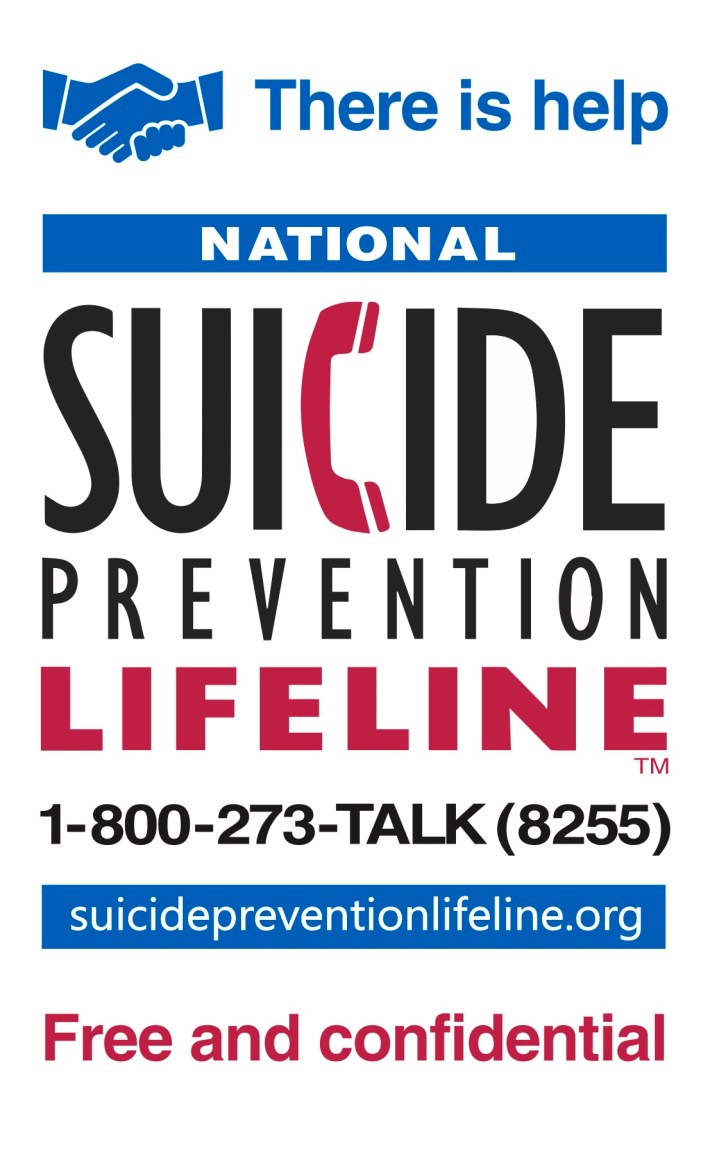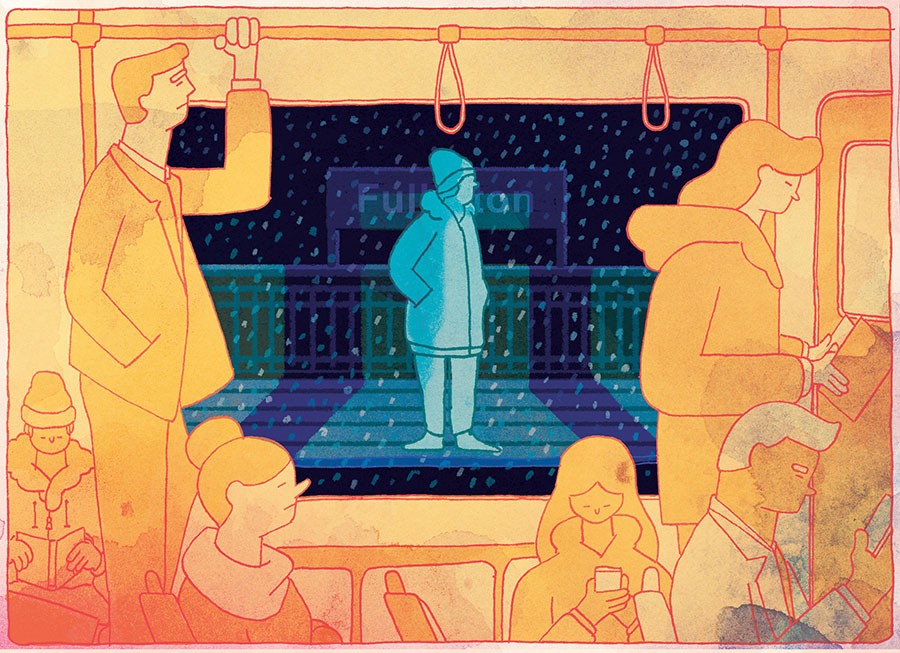[Streetsblog Chicago editor John Greenfield publishes a weekly transportation column in the Chicago Reader. We syndicate the column on Streetsblog after it comes out online.]
On December 1, 2015, school superintendent Diane Cepela called her son Matt at Central DuPage Hospital in west-suburban Winfield, where the 24-year-old was undergoing treatment for crippling clinical depression. She’d found a long-term residential home near Los Angeles that she thought he’d like, offering non-traditional therapy options like acupuncture and surfing. When Matt didn’t return her messages, Diane felt a pang of motherly instinct: something was wrong.
Diane characterizes Matt, who lived with his family in Shorewood, just west of Joliet, as a highly intelligent young man who was passionate about computer programming, music, the Blackhawks, and politics (he was particularly enthusiastic about Bernie Sanders). A rangy 6'6'' guy with hazel eyes and scruffy, sandy-blond hair, he resembled Shaggy from Scooby-Doo. He’d participated in cross-country, lacrosse, and wrestling, not because he was especially skilled at sports but because he enjoyed the camaraderie, she says.
Matt had “a gentle heart,” according to Diane. When it came to wrestling he was no Dan Gable, but he rarely got pinned because his height made it difficult for opponents to “wrap” him. But in his junior year of high school he once let a friend named Mike pin him in the JV wrestling tournament because Mike had never won a tournament and Matt had.
And once after a watching a high school football game, another teen jumped on Matt’s back and asked for a piggyback ride, Diane says. “After the ride I looked at Matt and he said, ‘Mom, it’s OK. He struggles in school, so we need to make him feel better.’ Matt was like that.”
While he was compassionate, Matt also loved to fiercely debate politics and theology, Diane says. “If missionaries came knocking, Matt would argue religion with them until I made him stop. His rationale was that they came to his house and if they wanted him to convert, they needed to convince him. Many poor, God-loving people were turned away thoroughly beaten.”
Diane adds that Matt was also an “animal whisperer,” whose best friend was his 100-pound Labrador retriever Lilly. Once when he was visiting his sister Jill, a screenwriter, and her boyfriend Michael in LA, Matt fell behind during a walk. When they turned around, he was petting a wild squirrel. “That was pure Matt,” Diane says. “He loved animals and they loved him.”

But severe depression had tormented him since high school, Diane says, when he told a counselor that he felt like “an island and the waters around him were confusion.” His condition was resistant to medication, with some drugs resulting in severe, stroke-like side effects that left him temporarily unable to speak.
In 2015 he spent six months in San Diego with his brother Jake, a programmer. During this time he worked at construction sites and a 7-Eleven, and he stopped taking his antidepressants altogether. “He wanted to live like a young man again and drink and see girls,” Diane says. “When he came back, he was pretty messed up. You could tell he was really struggling.”
In early November of that year Matt had a violent episode in which he punched walls and a television set in the family home, breaking his hand, and said he wanted to kill himself. After that he was hospitalized, first at Presence Saint Joseph Medical Center in Joliet and later at Central DuPage Hospital, to prevent him from harming himself further.
The day before Matt died, he and Diane drove from Central DuPage to his psychiatrist’s office at Northwestern Memorial Hospital’s Streeterville campus. They took the Eisenhower Expressway, which runs parallel to the Forest Park branch of the Chicago Transit Authority’s Blue Line, the tracks of which are located in the highway’s median. Diane says she believes that during the trip Matt noticed the train stations.
On December 1, when Matt didn’t reply to her messages, Diane called his therapist at Central DuPage, worried that her son was suicidal. After the therapist evaluated Matt later that afternoon, a hospital staffer called Diane to tell her that they didn’t believe he was an imminent threat to himself.
But around 3:30 or 4 that afternoon, Matt was somehow able to access the keys to his pickup truck, which was sitting in the hospital parking lot. He walked out of the facility, apparently unnoticed by hospital staff, Diane says, drove some 22 miles east to the Austin Avenue Blue Line station in Oak Park, parked nearby, and walked onto the platform. At around 6 PM he jumped onto the tracks and was fatally struck by an oncoming train, according to the Cook County medical examiner, which ruled the death a suicide.
“He had been in so much emotional pain,” Diane says. “A lot of people blame themselves [when a loved one commits suicide.] It’s a deep, dark rabbit hole. You think, what if I had done this or that. But I know that we tried everything we could to help Matt.”
A story like Matt Cepela’s reminds us that CTA rail suicide cases are more than just medical emergencies or police and fire investigations, as they’re described by the agency on intercom announcements and social media posts about the ensuing train delays. They’re devastating tragedies for family and friends that also traumatize the transit agency’s personnel and passengers who witness them. Moreover, these incidents can cause massive logistical problems, shutting down entire branches of the el system for hours and causing thousands of people to be late for work, resulting in lost wages and productivity.
An extreme example of disruption occurred on August 15 of this year, when Niles resident Dragan “Danny” Andelkovic, 41, dove in front of a train at the CTA’s Fullerton station around 6:30 AM in an apparent suicide, according to the Chicago Police Department. The Fullerton station is a transfer stop for the Red, Brown, and Purple lines, so service was disrupted on all of routes for about three hours while first responders recovered the victim’s body and investigated the scene. The transit agency scrambled to dispatch shuttle buses for the enormous crowds of waiting riders that formed outside the Fullerton and Belmont stations. Ride-hailing services jacked up the price of a downtown trip to $70 or more. (Uber and Lyft later refunded the surge charges.)
DePaul University transportation expert Joe Schwieterman provided an estimate on the cost of this kind of delay for CTA customers, using U.S. Department of Transportation estimates on the value of time for urban transit users to determine an average rate of $21.86 per lost hour. Schwieterman calculates that a one-hour hold-up during the morning rush hour that affects 36 trains with an average of 520 passengers per train (based on eight-car trains with an average of 65 people per car, well below the maximum standing capacity), for a total of 18,720 commuters, results in $409,000 in lost time. This number illustrates that, in addition to the incalculable human toll, train suicides are a major economic issue.
Our region’s extensive Metra commuter rail system has seen a rise in suicides in recent years. In 2012 there were 16 deaths, but the numbers continued to increase each year through 2016, when there there were 26 suicides or suspected suicides, according to spokesman Michael Gillis. This year started with a series of deaths, although the pace later slowed down with 18 confirmed or suspected suicides as of December 4. (While a November Chicago magazine report by Kim Bellware on Metra suicides stated that there had been 23 confirmed or suspected cases in 2017 to date, Gillis says that several of the suspected cases have since been determined to be accidents.)
In response to the rising numbers, Metra hosted a suicide awareness and prevention forum in September titled “Breaking the Silence” that included partner railroads, safety experts, and mental health professionals. In the wake of the conference, the railroad is trying some new intervention strategies, which I’ll discuss below.
Rail suicides are less prevalent on the CTA than Metra. That’s partly due to the degree of accessibility: the vast majority of CTA tracks aren’t located at street level, which means that one has to jump or fall, rather than just step, into the path of a train. However, the presence of the 600-volt third rail increases the chance that an attempt will be fatal. According to CTA officials, there have been an average of five confirmed suicides annually in the el system over the past six years, with five such cases in 2017 as of December 1. Unlike Metra, the CTA hasn’t seen a steady rise in suicides since 2012, when there were also five deaths on the el system, but there was a spike last year with eight suicides.
Here are the four other 2017 cases besides Andelkovic’s August 15 death that CTA investigations conclusively determined to be suicides, according to spokesman Steve Mayberry. On March 8 at 11:53 AM, 28-year-old Karol P. Koperny jumped in front of a train at the Addison Blue Line station. On April 4 at about 2 PM, a woman committed suicide at the Grand Red Line stop. On August 13 at around 5 AM, 23-year-old Brandon Vasquez killed himself at the Orange Line’s Ashland station. And on August 22 at about 1:35 PM, Christopher R. Esberger, 46, was found on the tracks of the Addison Brown Line station after he came in contact with the third rail. Additionally on September 18 a man dove off the platform of the Fullerton station in an apparent suicide attempt, about a month after Andelkovic reportedly killed himself at the same station. The man fell onto the tracks but was not struck by a train and was hospitalized in serious but stable condition, police said.
There are several strategies that transit systems can use to help prevent rail suicides, according to Polly Hanson, director of security for the American Public Transportation Association trade organization. Employees should be trained to identify behaviors that may foreshadow suicide attempts, such as pacing up and down a platform, lingering while multiple trains come and go, or leaving belongings behind when walking to another part of the station. Awareness campaigns can encourage fellow commuters to recognize warning signs and intervene as well. “Your customers are some of the best folks to help you with prevention,” she says.
Hanson adds that signs should be installed with suicide-prevention helpline numbers, especially at stops that have seen multiple deaths in the past. Metra is currently moving forward with these strategies, and will begin hanging posters with words of encouragement and a hotline number in stations and on platforms starting in early 2018, according to Gillis.

Platform screen doors are a physical solution to preventing suicides and accidental falls, as well as cases in which people are intentionally pushed onto the tracks. For example, on August 1 Chad Estep, a 34-year-old Northwestern neuroscience PhD grad from Wicker Park, allegedly shoved a stranger, 46-year-old Ben Benedict, off the Washington Blue Line platform. Benedict, who later testified that the attack was unprovoked, narrowly escaped being struck by a train. These doors, usually made of glass, are installed along the platform edge and are aligned with the train’s doors, only opening when the train arrives, which makes it virtually impossible for customers to wind up on the tracks. They also discourage people from throwing garbage onto the third rail, a cause of system-disrupting fires.
While platform screen doors are common in Asia and Europe, they’re practically nonexistent among major North American transit networks, although some airport monorails, such as O’Hare’s, employ them. Cost is one reason why the safety tactic hasn’t been used so far on underfunded U.S. rapid transit systems, although Philadelphia’s SEPTA rail network is currently looking into the approach. Former Metropolitan Planning Council staffer Yonah Freemark notes in his blog the Transport Politic that the price tag for platform screen doors can range from $2 to $10 million per platform.
Lanny Wilson formed the DuPage County Railroad Safety Council to prevent all types of railroad fatalities in 1994, shortly after his 14-year-old daughter Lauren was fatally struck by a Metra train in Hinsdale while she was a passenger in a car. Wilson says that recent technological developments offer additional hope for preventing rail suicides. In the U.K., where commuter rail deaths are more common than in the U.S., train riders are encouraged to download an app that allows them to click a button if they or another passenger are contemplating suicide. The app uses GPS to notify first responders of the location of the crisis. In the future, Wilson says, we may see transit agencies using smart video camera systems that can detect warning behavior, such as platform pacing, and notify employees.

The CTA is already starting to train employee in some of these strategies, according to spokesman Brian Steele. By the end of December the agency will begin installing awareness signs with the number for the National Suicide Prevention Lifeline. Installation will start with the five stations that have each seen two confirmed suicide cases in the last six years, all of them on the Red Line, including 63rd, Lake, Grand, Clark/Division, and Morse. Forty train stops near hospitals will also be prioritized, likely due to the nearby presence of people being treated for mental illnesses. The goal is to eventually post signs in all 145 el stops.
The CTA is also training employees to recognize people contemplating harm to themselves, Steele says. The 32,000 security cameras installed throughout the system are helpful for spotting telltale behavior, although not all of them are monitored 24 hours a day.
The agency is not currently considering platform screen doors. Steel cites the logistical, physical, and budgetary challenges of retrofitting the devices onto subway platforms that are more than 50 years old and el stations that are, in some cases, more than a century old. Another issue is “berthing,” lining up trains with specific spots on the platforms, which is currently done manually by CTA drivers, using targets marked on the platform, he says. Systems with platform screen doors, such as O’Hare’s, generally feature automated berthing.
One anti-suicide strategy that Steel says is definitely off the table is sending a bill for damages to the families of people who are killed by trains due to suicide or negligence, something rail companies have done in Japan and Belgium. The rationale for this policy is that it makes people consider the financial consequences to their loved ones before jumping in front of a train. Still, Steele says, “The grief that the families and friends of suicide victims have to endure is not something we want to compound.”
Steele emphasizes that, with an average of five cases per year, suicide is a less pronounced issue on the CTA than on Metra. “We provide 2,200 train trips per day, or 800,000 per year, so our numbers are extremely low.” But he promises that the agency will continue to pursue new strategies to prevent future heartbreak. “Even one suicide is one too many.”
Indeed, when Matt Cepela threw himself in front of that Blue Line train, he left a void that his loved ones will feel for the rest of their lives. “He was my son and we miss him like no other,” Diane says. Still, over the last two years she’s begun to make peace with her loss. “I believe that even after Matt died, his spirit continues.”
Soon after his passing the family traveled to southern California to meet up with Diane’s sister Ann in San Juan Capistrano, known as a haven for migrating cliff swallows. “While we were there, Ann and I were walking to a coffee shop when the pedestrian gate came down in front of some railroad tracks—but there was no train. After a while it finally went up and we continued walking.”
Later, Diane and Matt’s father John were walking near the tracks while a train passed by. “We weren’t really paying attention until the train blasted its horn right next to us,” she recalls. “We jumped, startled, we laughed, and then we cried, agreeing that it was Matt trying to get our attention. We could hear him thinking ‘Oh, OK, too much, right?’ and imagined him shrugging his shoulders and chuckling a bit.”
How you can help
Lanny Wilson of the DuPage County Railroad Safety Council says research shows that suicide attempts are usually unplanned, impulsive acts, and if you can stop someone from following through they probably won’t try it again. “Survivors have said that as soon as they jumped they thought, Oh my God, why did I do this?” He says that Elton John’s song “Someone Saved My Life Tonight,” which tells the true story of how a friend stopped him from killing himself in 1968, offers hope to those who are considering ending their lives. “Look at the incredible gifts he’s given the world since then.”
If you believe a person may be contemplating suicide, don’t leave them alone. Call the National Suicide Prevention Lifeline at 1-800-273-TALK (8255) or text “HOME” to 741741 to communicate with a trained volunteer at the Crisis Text Line. For more information, visit the American Foundation for Suicide Prevention at AFSP.org.




